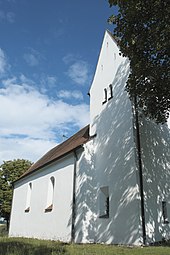Wengen (Burgheim)
|
Wengen
Burgheim market
Coordinates: 48 ° 39 ′ 40 ″ N , 11 ° 1 ′ 39 ″ E
|
|
|---|---|
| Height : | 440 m above sea level NN |
| Residents : | 122 (Jan. 1, 2016) |
| Incorporation : | July 1, 1972 |
| Postal code : | 86666 |
| Area code : | 08432 |
Wengen is a church village and part of the market Burgheim in the district of Neuburg-Schrobenhausen , which belongs to the administrative district of Upper Bavaria in Bavaria . The district also includes the hamlet with church Eschling and the wasteland of Hirst . At the end of 2015 Wengen had 91 residents and Eschling 31.
geography
location
Wengen is located five kilometers south of Burgheim in the flat tertiary heights of the Aindlinger terrace stairs . In terms of natural space, it belongs to the Donau-Iller-Lech-Platte , which in turn is part of the Alpine foothills , one of the main natural spatial units in Germany . Eschling is to the north and Hirst is southeast of Wengen.
Wengen is located on state road 2027 from Ehekirchen to Rain . Wengen is directly south of the road, Eschling north. The wasteland of Hirst is located south of Wengen at the end of a cul-de-sac.
Neighboring places
The neighboring towns of Wengen are the Rainer districts Etting , Tödting and Gempfing in the south-west, west and north- west, Kunding in the north-west, the main town Burgheim and Ortlfing in the north, Illdorf in the north-east, and the Ehekirchen districts of Holzkirchen , Buch and Haselbach in the east, south-east and south .
history
Excavations in the area indicate an early settlement: to the west of the place there is a Neolithic settlement in the brickworks, to the east a Bronze Age settlement. There are two barrows at Hirsthof.
Wengen is one of the oldest documented places in Upper Bavaria: In 864, Bishop Anno von Freising exchanged a farm in Uuengia from Count Cotascalc (Gottschalk). Bishop Waldo von Freising exchanged the Wengen possessions in 887 and 895 with the noble Erchanfried von Hohenwart. In the 11th and 12th centuries, the Counts of Scheyern (relatives of the Hohenwarter) and the marshals of Schiltberg appear as the lords of Wengen . In 1268, Count Bernhard I von Scheyern gave the Scheyern Monastery a farm in Wenga . In 1268 Marshal Bertold von Schiltberg donated several farms to the Niederschönenfeld Monastery .
Around 1800 there were the following landlords in Wengen: the curb-Bavarian caste office Rain (since Wengen belonged to the district court Rain), the monastery Niederschönenfeld and the monastery Indersdorf , the counts of Sandizell and the barons Hörwarth on Aiterberg.
Eschling was first mentioned in 1214 as Eschelingen and at that time belonged to the Lords of Pappenheim . In 1800 the Eschling landlords were the Scheyern Monastery, the Frauenkapelle in Rain and the Frauenkirche in Ingolstadt ; the rest belonged to the caste office Rain.
The Hirsthof ( settlement on the bushes ) was also first mentioned in 1214 under Hurstin or Hürsten as a property of the Pappenheimer. Since 1500 the farm belonged to the Thierhaupten monastery .
The Catholic branch church Sankt Ottilia in Wengen belongs to the parish of St. Cosmas and Damian in Burgheim. Of the oldest late Romanesque church, the tower and the west wall of the nave still stand. The choir and the rest of the nave were built around 1600. In 1913 the ship was extended to the west. Parts of the
Catholic Church of St. Johannes Evangelist in Eschling (tower, adjacent south nave wall) date from 1300. The rest of the church was rebuilt after it was destroyed in the Thirty Years' War. It is worth mentioning a
three-dimensional representation of Christ's instruments of suffering from 1800. The Hirsthof traditionally belongs to the parish of St. Michael in Haselbach .
On July 1, 1972, the independent community of Wengen, which belonged to the district of Neuburg an der Donau , was incorporated into the Burgheim market.
On May 30, 2005, the inhabitants were startled by the crash of a military plane between Eschling and Illdorf ; There were no deaths, injuries or damage to buildings.
Individual evidence
- ^ Wilhelm Volkert (ed.): Handbook of Bavarian offices, communities and courts 1799–1980 . CH Beck, Munich 1983, ISBN 3-406-09669-7 , p. 532 .
swell
- http://www.burgheim.de
- Population register 1964 Neuburg / Donau
- Wengen in the location database of the Bayerische Landesbibliothek Online . Bavarian State Library

